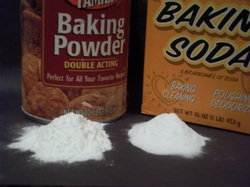
How long have they been around?
Baking powder is a combination of alkaline, acid (cream of tartar), and starch. You don't need to use acidic ingredients in recipes using just baking powder, since the balance is already there. Most baking powders are made with two different alkaline powders- one that reacts right away (baking soda), and one that reacts only with heat. This way you can save some of that leavening power for when the food is actually IN the oven. The starch is there to help absorb moisture so the powders don't react in the can and to help the powder stay free-flowing.
To use baking soda instead of baking powder, use 1/3 the amount, and make sure there's something acidic in the batter. For instance, if your recipe calls for 1 Tbsp (which is 3 tsp.) baking powder, you can use 1 tsp. baking soda, and use buttermilk- or sour milk- instead of regular milk. Or mix in 1 tsp. cream of tartar. Or use brown sugar instead of white.
This works in reverse, too: if your biscuit recipe calls for buttermilk and you only have plain milk, use it but switch that 1 tsp. baking soda for 1 Tbsp. baking powder (or whatever it calls for, keeping that 1:3 ratio).
As far as I can find, baking powder wasn't invented until the 1800's, but leavening powders have been around at least for centuries. Some of the earlier ones include:
Baker's Ammonia (ammonium carbonate, "hartshorn"; NOT cleaning ammonia!- which is poisonous)- made from powdered reindeer horn. (Seriously.) This one actually has characteristics more of baking powder, substitutes 1:1 for it, and makes cookies especially crisp and light.
Potash or pearl ash (potassium carbonate, an alkaline salt)- made by adding water to the ashes of 'vegetables' or weeds, steeping overnight, then evaporating all the water by boiling. The fine 'ash' left is used as baking soda. There's a fascinating article on the process in the 1802 "Domestic Encyclopedia"
Saleratus, or soda ash (sodium carbonate, an alkaline salt)- also known as washing soda... sometimes used also in the boiling water step of making bagels, as it helps them brown better (Maillard reaction!!!). An interesting bit of chemistry with this one is that when you heat sodium bicarbonate (baking soda) by itself above about 160 F, you end up with sodium carbonate (washing soda), with byproducts of carbon dioxide and water (which dissipate into the air). 2NaHCO3(sodium bicarbonate) → Na2CO3(sodium carbonate)+ H2O + CO2 (It works fastest at 400 F.)
Baking soda's first large-scale appearance was in 1846, when a factory was built to make this new product, created by doing the opposite of the formula above- dissolving sodium carbonate in water, then pumping in carbon dioxide. (There's a more efficient method now.)
Can you believe we've had this useful leavener less than 200 years, and baking powder less than 150? Boy, are we spoiled in the kitchen nowadays...
Read more:
http://www.foodsubs.com/Leaven.html
http://en.wikipedia.org/wiki/Saleratus
http://en.wikipedia.org/wiki/Washing_soda
http://chestofbooks.com/reference/The-Domestic-Encyclopaedia-Vol3/Pearl-Ash.html
 RSS Feed
RSS Feed